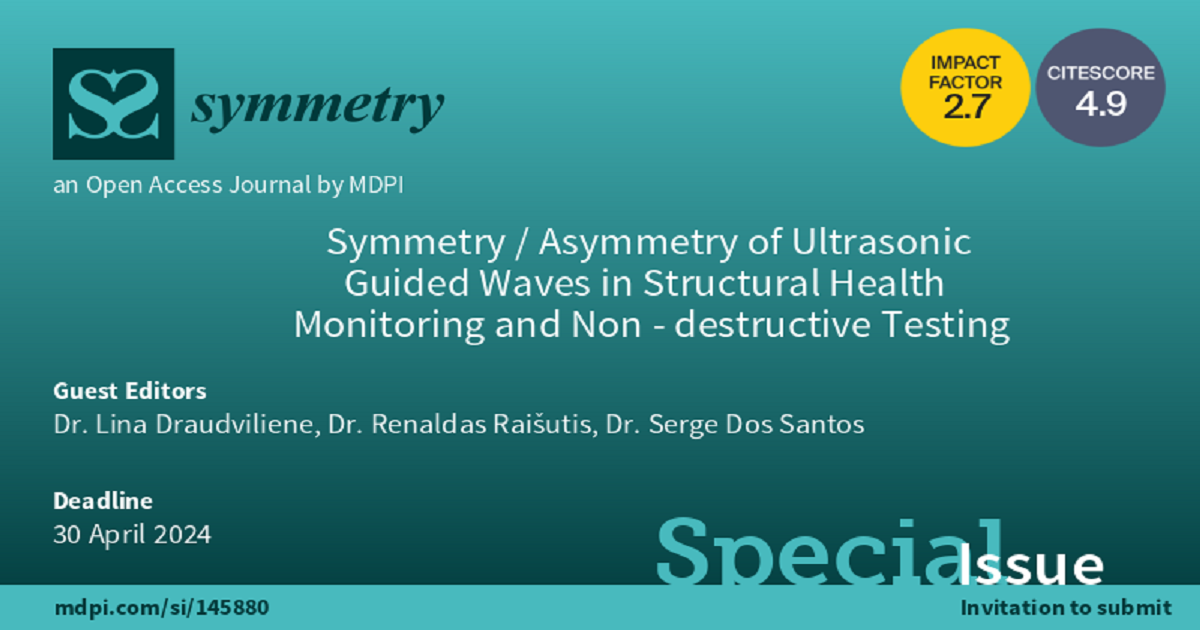Symmetry/Asymmetry of Ultrasonic Guided Waves in Structural Health Monitoring and Non-destructive Testing
A special issue of Symmetry (ISSN 2073-8994). This special issue belongs to the section "Engineering and Materials".
Deadline for manuscript submissions: 30 April 2024 | Viewed by 1445

Special Issue Editors
Interests: ultrasonic guided waves measurements; non-destructive testing; structural health monitoring; material characterization; guided waves applications for testing of the composite materials; signal processing
Interests: power systems; renewables; uncertainty analysis; digital signal processing; smart materials
Special Issues, Collections and Topics in MDPI journals
Interests: ultrasound; nonlinear acoustics; signal processing; nondestructive testing; nonlinear time reversal; NDE4.0; TR-NEWS
Special Issue Information
Dear Colleagues,
Nowadays, the ultrasonic guided waves (UGW) method is an attractive and well-known technique for non-destructive testing (NDT) and structural health monitoring (SHM) tasks. The utilization of these waves for ensuring the compliance of objects with safety requirements by detecting structural changes during manufacturing and performing monitoring during the service life is an effective tool for environmental sustainability. Lamb waves, one type of UGW generated in plates and shell components, represent a promising solution for the failure prevention of various types of objects in future. There are two groups of dispersive modes of Lamb waves: symmetric and anti-symmetric. These dispersive modes, which propagate along the object under investigation, are highly sensitive to the properties of the material, sensitive to cracks at different depths, and can propagate over a relatively long distance (up to 100 m). Therefore, using the registered signals of Lamb waves, the early degradation of materials and the evaluation and detection of damage inside the structure are obtained faster and more sensitively. Since various types of objects can be inspected for internal defects using symmetric and anti-symmetric modes of Lamb waves to ensure that they meet safety and economical requirements, the utilization of such waves therefore plays a huge role in ensuring safety and environmental sustainability. However, irrespective of all of the good features associated with Lamb waves, the testing of objects is still a quite complex and challenging task due to the dispersion phenomenon, with the infinite number of dispersive symmetric and anti-symmetric modes. This Special Issue aims to present advances in signal processing relating to the UGW technique, including (but not limited to) the novel developments regarding Lamb wave-related methods, time reversal-based nonlinear elastic wave spectroscopy methods, the reliability evaluation of methods, and applications of non-destructive testing (NDT) and structural health monitoring (SHM).
Dr. Lina Draudviliene
Dr. Renaldas Raišutis
Dr. Serge Dos Santos
Guest Editors
Manuscript Submission Information
Manuscripts should be submitted online at www.mdpi.com by registering and logging in to this website. Once you are registered, click here to go to the submission form. Manuscripts can be submitted until the deadline. All submissions that pass pre-check are peer-reviewed. Accepted papers will be published continuously in the journal (as soon as accepted) and will be listed together on the special issue website. Research articles, review articles as well as short communications are invited. For planned papers, a title and short abstract (about 100 words) can be sent to the Editorial Office for announcement on this website.
Submitted manuscripts should not have been published previously, nor be under consideration for publication elsewhere (except conference proceedings papers). All manuscripts are thoroughly refereed through a single-blind peer-review process. A guide for authors and other relevant information for submission of manuscripts is available on the Instructions for Authors page. Symmetry is an international peer-reviewed open access monthly journal published by MDPI.
Please visit the Instructions for Authors page before submitting a manuscript. The Article Processing Charge (APC) for publication in this open access journal is 2400 CHF (Swiss Francs). Submitted papers should be well formatted and use good English. Authors may use MDPI's English editing service prior to publication or during author revisions.
Keywords
- signal processing methods
- symmetric and asymmetric modes
- phase and group velocity dispersion curves
- reliability evaluation of methods
- uncertainties
- guided-wave modelling and propagation
- multimodal guided-wave representation
- time reversal-based imaging
- coded excitations
- non-destructive testing (NDT)
- structure health monitoring (SHM)
- on-site and in-service structural diagnosis
- damage diagnosis
- damage identification and evaluation
- prognosis






